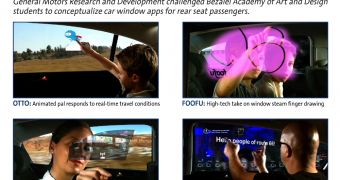General Motors Research and Development (GM) challenged researchers and students from the FUTURE LAB at Bezalel Academy of Art and Design in Israel to come up with some way of making car rides more enjoyable for passengers.
As any rules and regulations book will clearly spell out, car drivers should have their eye and mind on the road at all times.
They also should never remove their hands from the steering wheel, unless it is for changing gears or other driving-related maneuvers.
In other words, drivers don't need an augmented reality window to distract them, except, perhaps, in the cases where a GPS map or something of the sort is displayed.
The situation is vastly different for passengers, though.
Knowing this, GM asked students and researchers at Israel's Bezalel Academy of Art and Design to create apps that can help people of all ages enjoy long car rides more.
The project, called Window of Opportunity, is an augmented reality window that, through use of apps, can allow anyone to write or draw on them.
The Window of Opportunity has already been tested in a full-size model of a car.
The idea came about due to psychological studies that suggest car passengers often feel disconnected from their environments.
“Traditionally, the use of interactive displays in cars has been limited to the driver and front passenger, but we see an opportunity to provide a technology interface designed specifically for rear seat passengers,” says Tom Seder, GM R&D lab group manager for human-machine interface.
“Advanced windows that are capable of responding to vehicle speed and location could augment real world views with interactive enhancements to provide entertainment and educational value.”
Various apps were created, some of which rely on music, message or picture sharing and others, which make it seem as though someone is drawing on fogged-over glass.
No clue yet on how long it will take for augmented reality car windows to become a common feature of vehicles.
“Projects like WOO are invaluable, because working with designers and scholars from outside of the automotive industry brings fresh perspective to vehicle technology development,” states Omer Tsimhoni, lab group manager for human-machine interface, GM Advanced Technical Center in Israel.
“WOO is just one of many projects underway at GM that could reinvent the passenger experience in years to come.”

 14 DAY TRIAL //
14 DAY TRIAL //